What Are Journey Maps and Why Do They Matter?
Learn how to deliver a journey map that solves business problems and communicates information to help improve customer experience.

Many of you probably use journey maps to identify new features you might want to eventually add to your products as a way to improve the user experience. I've been there.
But do new features really move the needle?
I have another proposition for you. What if instead you used a journey map to shape and mold entire stages of your customer experience? Assuming that’s possible, herein lays the difficulty—journey maps need to be reconsidered and built with systems thinking if you want to conquer entire stages in a customer experience all at once.
Now that would move the needle, wouldn't it?
In this very lengthy Triangle Offense post, I want to take some time to explain my approach and how I understand journey mapping. As I do, you’ll most likely recognize that I’ve begun to diverge from mainstream CX and UX practices regarding journey maps and the mapping process.
The reason I’m starting to diverge is that I’m pursuing truth. Only the customers tell me their truth, and I strive to build journey maps that can deliver it.
So get comfortable, grab your coffee, and dive into your topic of choice.
What is a Journey Map?
A journey map is a customer experience (CX) document that visually tracks a customer's chronological journey and highlights the most critical moments in the customer experience.

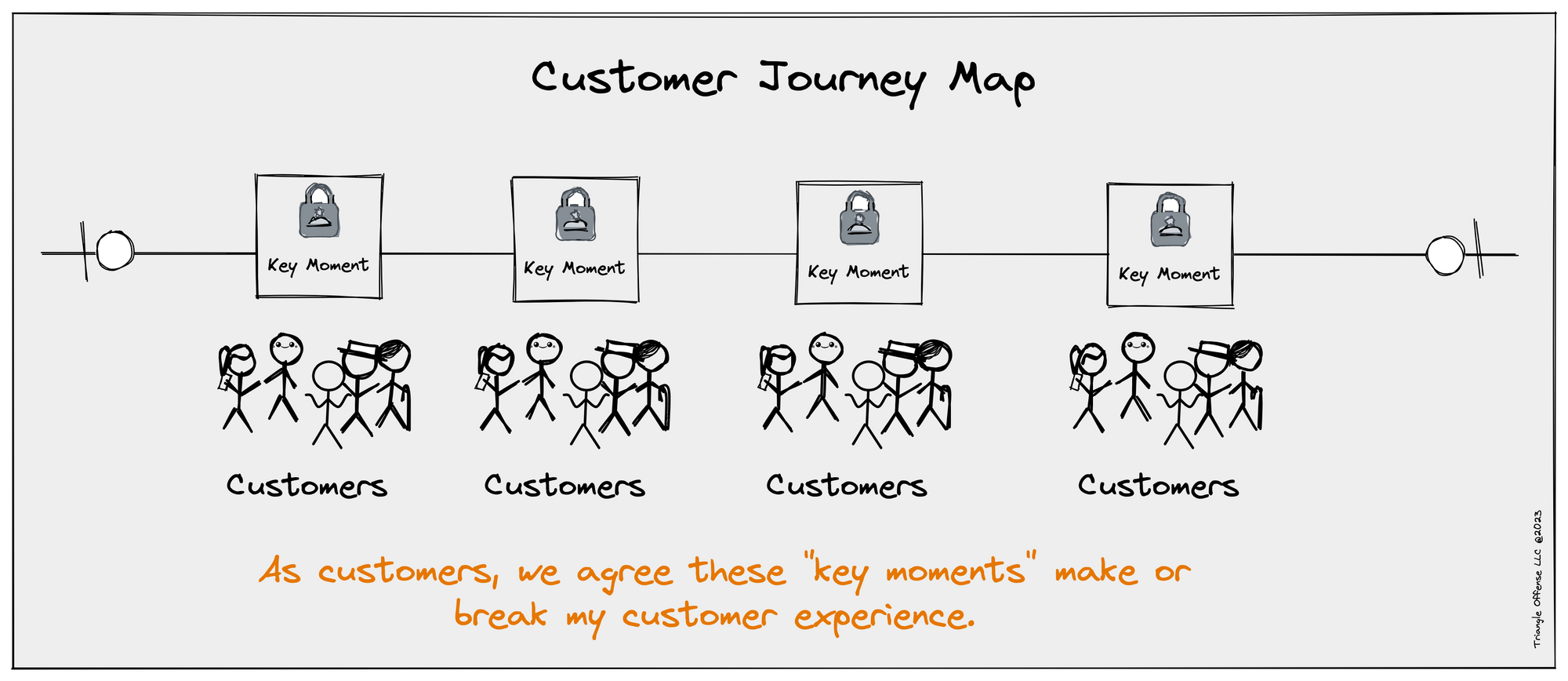
A journey map is a customer experience (CX) document that visually tracks a customer's chronological journey and highlights the most critical moments in the customer experience.
It’s a flexible CX documentation method that a business can use to map all or part of complex customer journeys. The journey map is a sophisticated CX record that requires a skilled professional to build, maintain, and operate it throughout its life cycle.
If that journey map definition sound generic and bland it’s because our Google overlords need a good SEO description of what we’re trying to tackle on this page. Now, let's get more background on journey mapping and why we should care about it.
Why is Customer Journey Mapping Important?
Here are some serious stats from different studies highlighting why a business needs to understand its customers.
- Thirty-three percent of customers would consider switching companies after just one instance of poor customer service. (Source)
- Only one out of 26 unhappy customers complains; the rest churn. The lesson here is that companies should not view the absence of feedback as a sign of satisfaction—the true enemy is indifference. (Source)
- Ninety-one percent of unhappy customers who are non-complainers simply leave. (Source)
- Customers who rate companies with a high customer experience score are seven times more likely to purchase more from that company. (Source)
Wow, those stats tell their own story, don’t they? When a customer gives more in a transaction than a business gives them in return, the customer feels like the business took too much from them. That customer then vanishes, never to return.
However, if a business has a seamless and well-considered customer experience, their customers are far more likely to become repeat buyers. You want that repeat business because selling to a known customer is much easier than attracting new customers. (Plus, it's a lot more expensive to attract new customers.)
What Can a Business Do to Understand Its Customers?
We know that a business must learn about customers' unmet needs. If they don't recognize those needs and understand how to improve the customer experience, customers will vanish into thin air.
Businesses need a reliable method to systematically discover opportunities to improve their customer service, and one of the best ways to understand customers is to map their experience. To that end, journey mapping can be a powerful method to assist you in understanding your customers ... but here's the thing: You don't just want to know a few specific things about customers; you want to understand their entire journey.
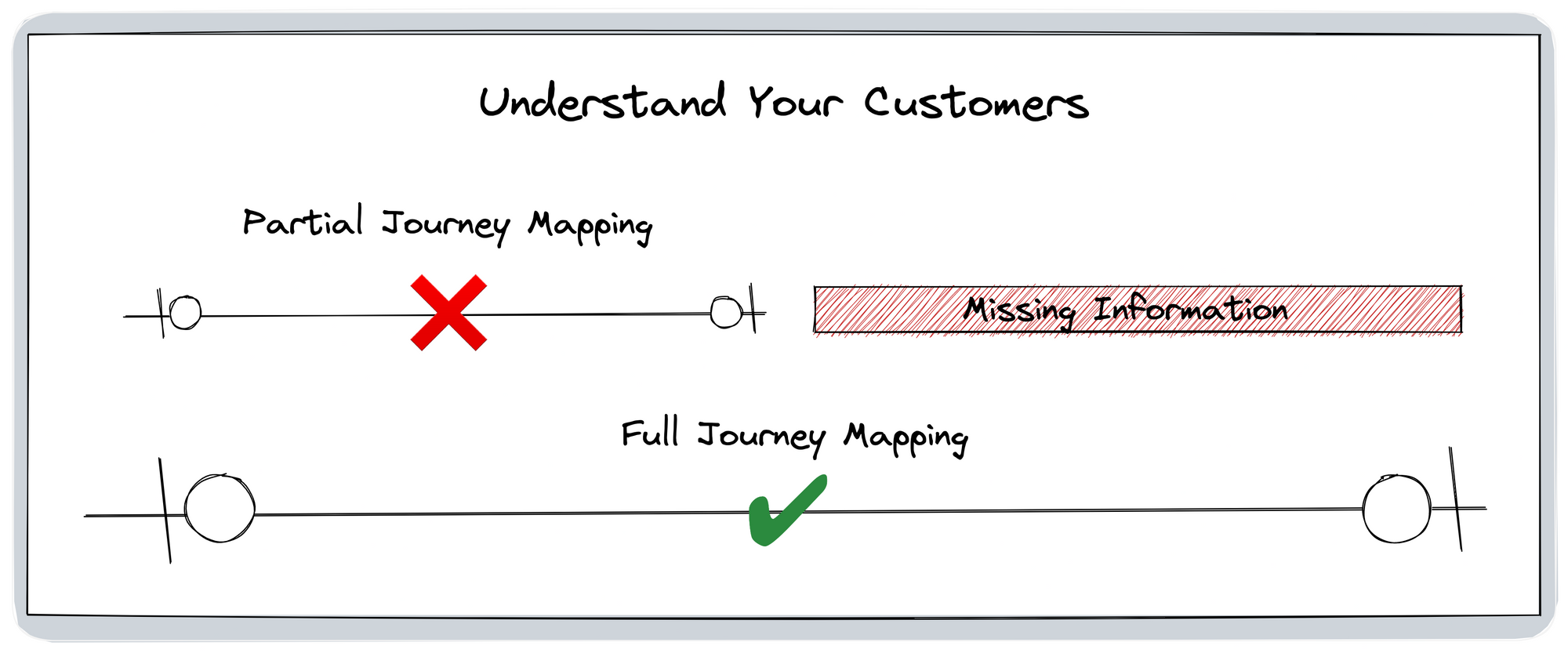
You want to understand the customers’ needs within the context of the entire customer experience. Why? Because it's tempting to think, “Well, we've heard a lot of complaints from customers about specific problems, so let's focus all our attention on those areas.
But you need to understand customers’ entire journey first. Then, once you’ve evaluated all their needs (see customer complaints), you can make a much better decision about prioritizing. If you decide to fix something in the customer experience and have only seen half of all the customer complaints, that’s a problem. In that case, you’re working with outdated information that could lead you to fix the wrong problem.
What Makes a Good Customer Experience?
A good customer experience depends on customers’ overall perceptions and feelings about a brand resulting from their interactions with the business across all channels (website, app, or phone) and touchpoints (staff interaction, etc.).
Customer experience encompasses every aspect of the customer's journey and interaction with the brand, including the product quality, the ease of use, customer service, and the overall satisfaction customers derive from their relationship with the brand.
Customers have very high expectations and expect a good, seamless experience. Furthermore, they hope that a company can personalize their offerings in a way that helps them meet their needs. Customers want a business to give them a lot in return when they go to the time and expense of transacting business with that organization.
A good, seamless, and connected experience is necessary for any business operating in this economic environment. With so many competitors, a company must be relentless in solving customer pain points as fast as possible. To do so, the teams managing the customer experience need to be experts in mapping a customer journey.
The Journey Mapping Process
It's important to note that journey mapping is usually initiated to solve a business problem or support a broader business strategy, meaning you don't want to engage in journey mapping just for the sake of journey mapping. The process can take a significant time investment, and you don't want to waste company resources and time.
I’ve outlined some steps a team could walk through to ensure they get the most value from their journey map and its process. I prefer these steps because they’ve historically given me the most significant chance to succeed and deliver a journey map that communicates information relevant to solving a business problem or helping with overall business strategy.
Of course, I want to mention that others have written extensively about journey mapping, and different ways to journey map a business's customer experience are available. Still, I prefer this method because I’m biased toward solving customer problems within the context of a business problem.
Step 1: What Business Problem Do We Need to Solve?
First of all, you should understand what business problem needs solving. For example, let's take a look at a typical problem businesses encounter:
Scenario: You want to generate more revenue from your B2B customer segment.
Business problem: Identify and prioritize critical areas for improvement in the product offerings, services, and customer experience for your large B2B customer segment.
Why would you want to understand the customers’ perspective? Because your team could be looking at the customer lifetime value (CLV) of the large B2B customer segment and see that it’s very profitable. Therefore, you wonder how to speed up customer acquisition and keep your current customers happy because this type of customer basically prints money for you.
Again, you want to understand how to support a business strategy or solve a specific business problem before you start doing customer research. Ask yourself, “Why do I need to journey map? What do I hope to achieve when the journey map has been completed?”
Step 2: Determine Customer Research Methods
Next, you should determine the type of customer research methods required to understand the customers’ needs within the business problem context. Did that sound complicated? Let me clarify it for you. I'm asking myself what customer segment I need to understand better and on which areas I should focus as I look at the entire customer experience.
I wrote a Triangle Offense post about the difference between CX and UX and why it leads to different research methods for each team. Take a minute and determine which research methods are best-suited for the journey mapping you will undertake.
You’ll end up selecting methods from the following:
- CX research methods
- UX research methods
- Or a combination of both
In my experience, journey mapping typically involves a mix of CX and UX research methods.
Step 3: Decide the Type of Journey Map You Need
At this point, you may be asking yourself, “What type of journey map should we use? Should we use a standard template? If so, where can I find those?”
Well, those are great questions. Because of other people's work, we know many businesses are utilizing five standard journey maps. Let's take a look at them:
- Generic customer experience journey map (looks across the entire experience)
- Buyer journey map (how a customer buys something)
- User journey map (how a customer uses a product)
- Omnichannel customer journey map (looks at all channels—web, app, phone, etc.)
- Archetype-based journey map
But wait, you can also use other valuable journey maps to understand the customer better. Here they are:
- Emotional journey map
- Lifecycle journey map
- Day-in-the-life journey map
- Jobs-to-be-done journey map
The type of journey map you choose will play a significant role in your mapping project’s success.
Step 4: Aggregate Relevant Data and Research
People generally assume that building a journey map involves folks talking to customers in the field and bringing back valuable insights. However, the effort of pulling together all relevant data goes beyond compiling customer research and reporting on field-generated insights.
Following are some everyday research activities you must complete when building a journey map:
Old research: First, ask whether you have data from previously-completed research activities. Try to find out if other people in your organization have done something similar and ask for their research documents. You’d be surprised how much great information is floating around your organization already that you can readily use to build an excellent journey map.
Customer interviews: If done right, customer interviews are still the gold standard for collecting customer data. However, this type of research requires patience because talking to a large pool of customers takes time, and the pool must be large to get a clear picture of what’s really happening in a customer experience. Also, not all customer interviews are of equal value because you have to find the most valuable interview able customers (ViCs) who’ll provide you with the most actionable information.
Customer feedback: Your business will receive much useful customer feedback via surveys and unsolicited complaints. Always ask other customer-support teams on the front line for their views; their perspective about what they've heard is important. The people closest to the customers usually have their fingers on the pulse of what customers are doing and saying during their interactions with your business.
Product data: You’ll want to access product data throughout your customers’ experience. For example, how many users use a product? How many logged in, and how long did they stay logged into a product? What type of activities are they engaging in with the product? How long does it take them to complete their tasks? You may not necessarily add product data to a journey map, but again, you want to understand the customer experience, and it's always nice to have some context regarding how customers use products and services.
Financial data: Surprisingly, pulling up the financials is not something people immediately think of when building a customer-experience journey map. However, with the exception of startups looking to match customer needs with a brand-new product, most of us work on and in a business focused on improving the customer experience. I recommend you pull up your business's financial goals and then loop in the segment-specific customer financial data. Nothing says “impact” like impacting your balance sheet.
Step 5: Synthesize and Display Findings in Journey Map
When you build a journey map, you create it with an audience in mind. You should be aware of the following audiences:
- Executive audience
- General business teams (including operations, finance, HR, etc.)
- Go-to-market teams (including sales, marketing, and customer success)
- Product teams
You have to meet the teams where they are. Don’t expect a general business or GTM team to look at a journey map from the perspective of a product team, or worse, from the perspective of a research team. Simplify the journey map and boil it down to the most important events customers experience, which impact business at the end of the day.

Five Common Journey Map Templates
Journey mapping is a highly-skilled activity that requires a bit of practice before you can master it. But thankfully, we know that at least five typical journey maps are out there, which makes it easier to select the appropriate one for the job.
I encourage you to think about a journey map not as one extensive document, but as many little documents, each representing a stage of the customer experience. When you think of it as many smaller documents that all fit together as one journey, it's not as overwhelming because you can start with what you already know about the customer. I love systems thinking because it helps us simplify how we tackle complex problems without sacrificing the journey map’s quality.
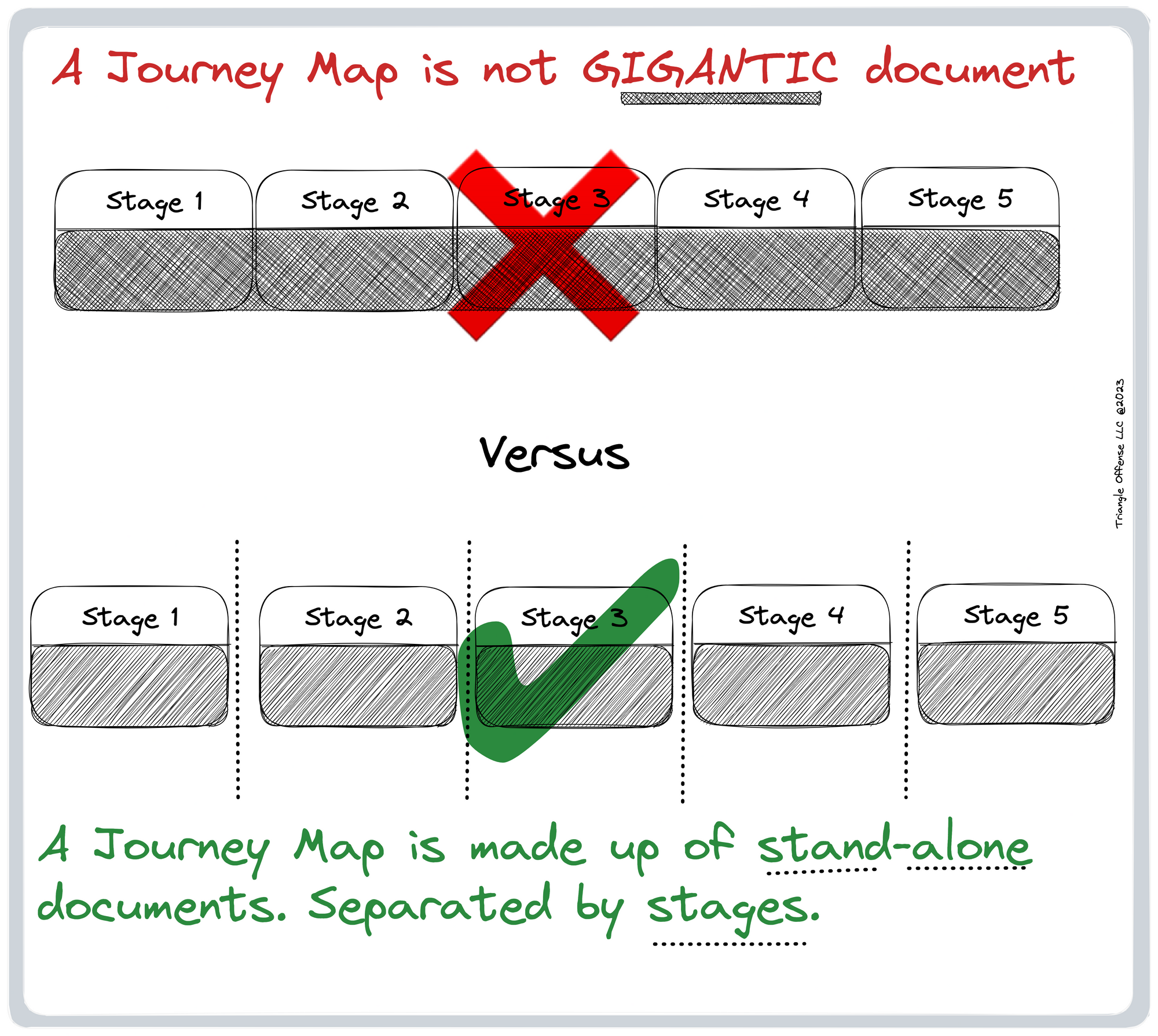
1. Generic Customer Experience Journey Map
Let's start with the most common journey map available to us. The generic customer journey experience map is the most basic journey map you can use to help you understand your customers. If your business doesn’t use any journey maps or is considering mapping its customer experience, you might want to start with this template.
This CX document forms a business's foundation for understanding its customers. In this Triangle Offense post, I discuss the value of mapping your core business model’s customer experience. This journey map outlines your customers’ general stages when they interact with your business, helps you understand the overall customer experience, and identifies areas for improvement across all touchpoints.
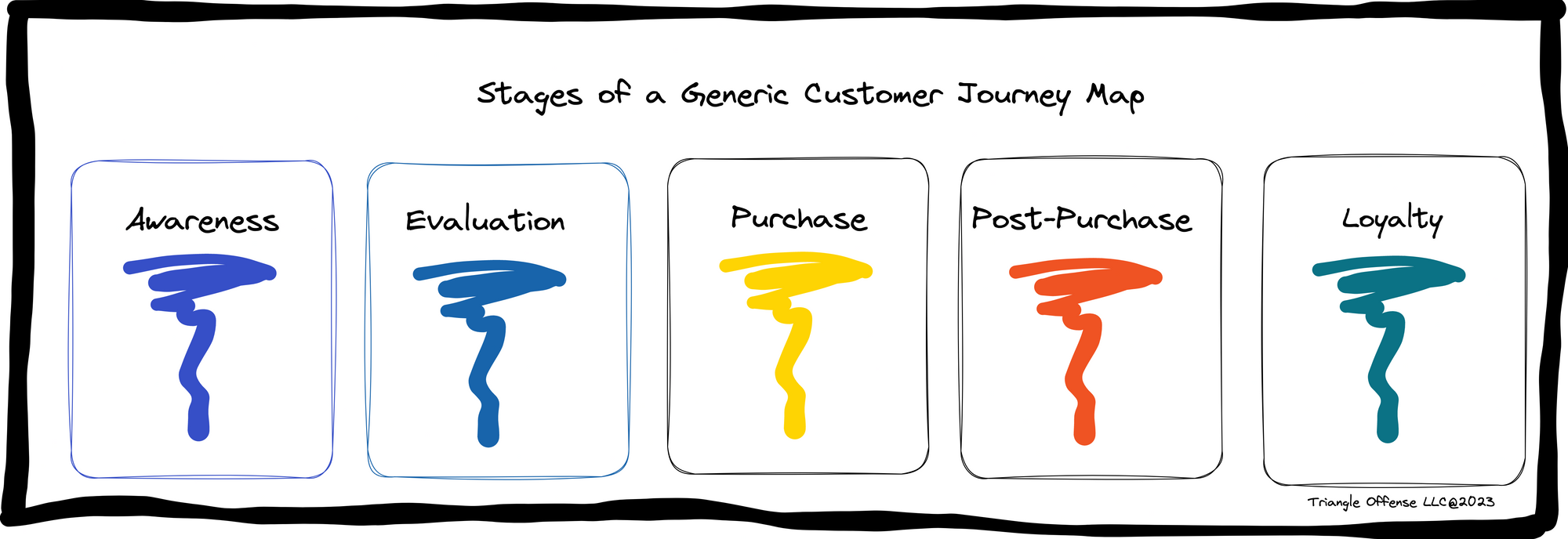
2. Buyer Journey Map
The buyer journey map focuses on a customer’s purchase experience. It helps you understand how a customer moves through a buying experience. You’ll want to create this type of journey map when it needs more detailed information than the generic customer journey experience map can provide. The go-to-market (GTM) teams, including the sales team, can benefit from this buyer's journey map if they want more insight into their selling process.
You can use the buyer journey map in a variety of situations. For example, a SAAS business may want to understand how its customers purchase its products. Or a B2B business will want to conduct a deep dive into an important customer segment and walk away with a 360-degree understanding of how that customer segment purchases products from them.
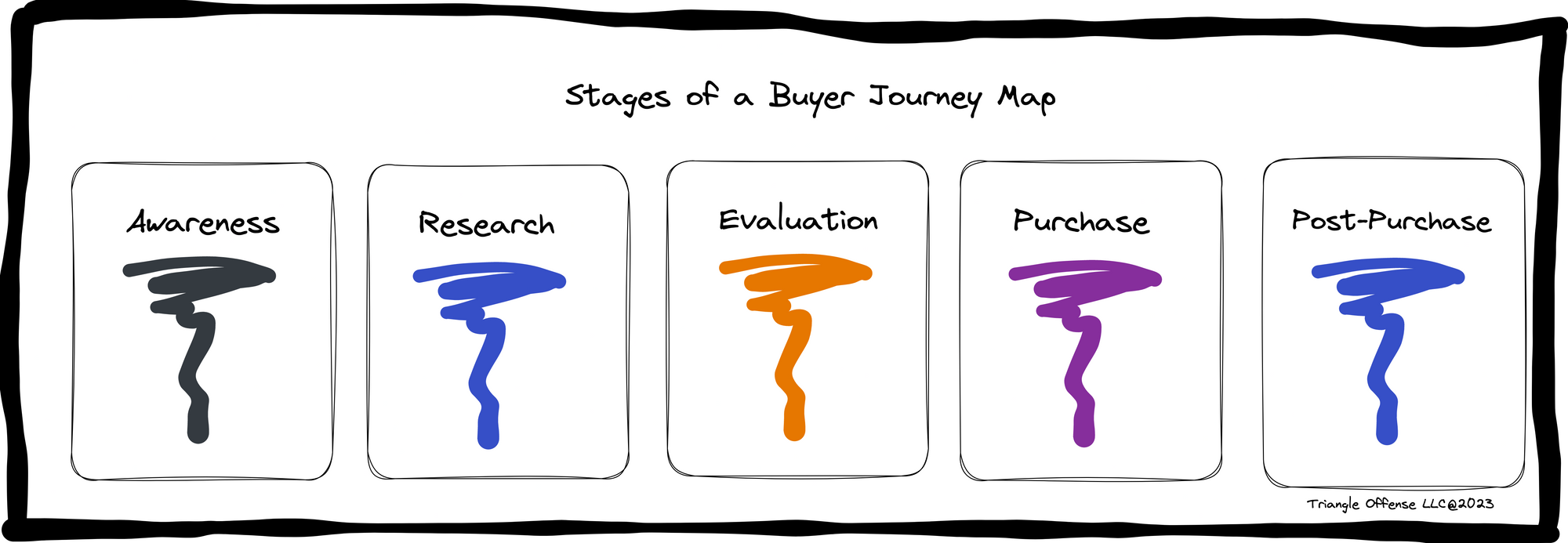
3. User Journey Map
When you want to understand how your customers use your products, you would use a user journey map. A user journey map examines the user's product experience, focusing on usability, functionality, and overall satisfaction. A product team can use the user journey map to identify areas for improvement in the user experience and boost user satisfaction.
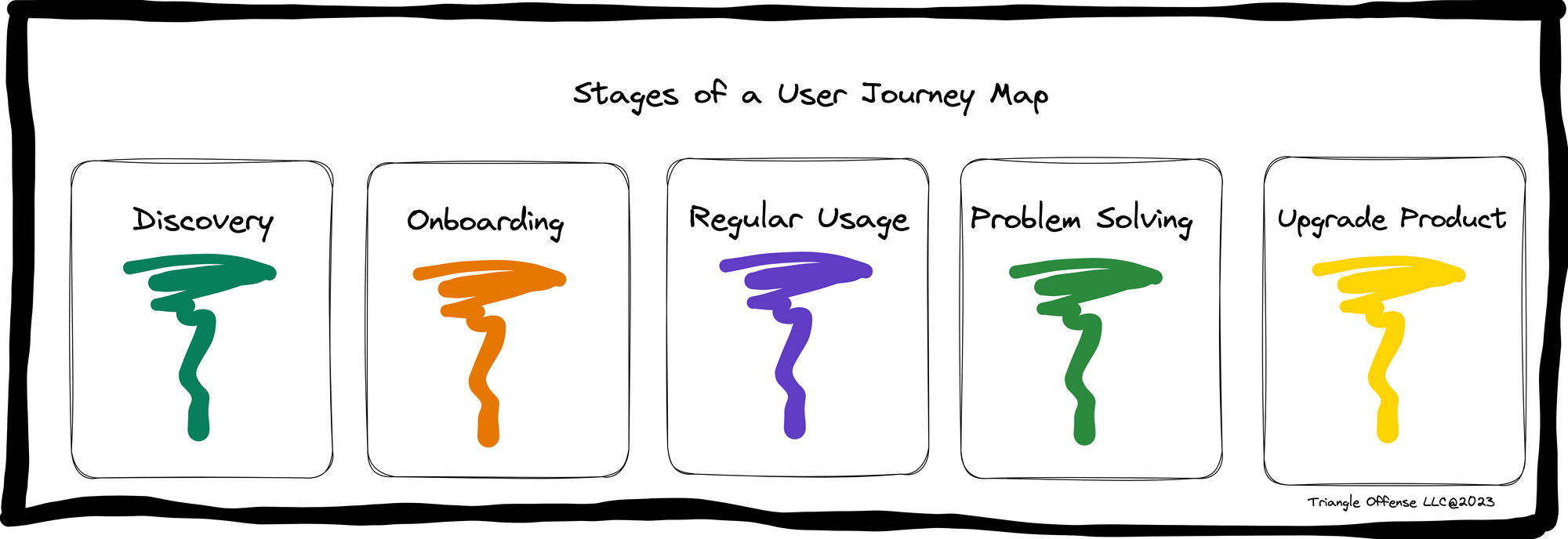
4. Omnichannel Customer Journey Map
The omnichannel customer journey map captures customer experiences across multiple channels such as websites, mobile apps, social media, and physical stores. The omnichannel journey map helps businesses understand how customers move between channels and where opportunities might be to create a more seamless and consistent experience.
A business may have a brick-and-mortar store but create a website to sell its products online. This business has now introduced a new channel and will want to understand the connections between its physical store and the website. Omnichannel selling is quite difficult to master, so this map can assist you.
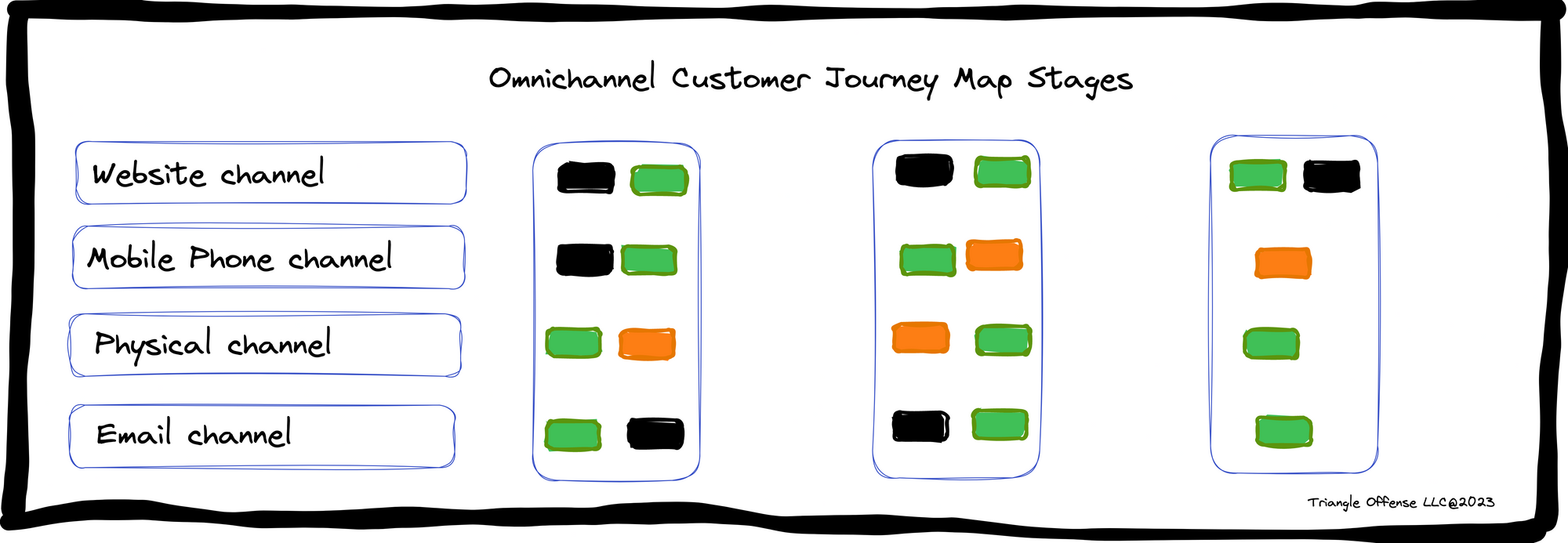
5. Archetype-Based Journey Map
This map type is tailored to a specific customer within a segment and allows you to understand that customer’s unique needs, preferences, and pain points. By mapping the journey for each archetype, organizations can tailor their marketing and product offerings to better meet each customer segment's needs.
Customer segmentation naturally occurs when a business grows. Therefore, as you grow, you’ll want to understand your most important customer or user segments, look for ways to retain those customers, and improve the customer experience where it’s most needed.
Journey Map Elements

Journey Map – Individual Stage
Journey map stage:
- A stage is made up of several key, grouped moments.
- Stages break the journey map into logical, easily-communicated steps.
- Stages simplify the customer data presentation to other teams.
- Using Starbucks as an example, we identify the moment when a customer orders a drink as the purchase stage of the customer journey. The purchase stage is made up of several key moments.
- Read this Triangle Offense post, "What is a stage in a journey map?" for a deeper dive into the concept of stages.

Journey Map – Key Moment
Key Moment:
- A key moment is a crucial point in a customer's experience that significantly impacts their overall perception of a business.
- A key moment, also known as a moment of truth, is the most critical piece of customer information a business needs to understand.
- A key moment comprises customer tasks that the customer completes because of a need.
- In the Starbucks example, the customer expects to be able to order their drink of choice. When they can do so, they will think favorably of Starbucks.
- Read more on key moments in this deep dive here.

Journey Map – Customer Goal
Customer Goal:
- What is the customer trying to achieve? The goal is the final state the customer wants to reach.
- To find the customers’ goals, we have to talk to them customers and ask. What are they trying to achieve?
- In the Starbucks example, the customer aims to order and enjoy a coffee.
- Learn more about customer goals in this post.

Journey Map – Customer Need
Customer Need:
Observe your customer and then ask what you can do to help them achieve their goal. A need is everything required to reach the end goal.
- To find the needs, talk to your customers, observe them, and ask them what you are doing or what you used to do. Observation is critical here.
- For example, the customer who wants to order a coffee needs a menu, the ability for Starbucks to customize a drink, and access to knowledgeable staff.
- Viking Range, a luxury kitchen appliance manufacturer, nails their customer needs. Learn here how they did it.

Journey Map – Customer Task
Customer Task:
- All customers have needs; when they interact with a business, they complete tasks to fulfill those needs.
- In the Starbucks example, the customer has at least six tasks to complete throughout the purchase stage to order his or her coffee.
- Know the difference between customer and user tasks in this Triangle Offense post.

Journey Map – Channels
Channel:
- Businesses use channels to sell a product or service.
- A channel is defined by how a customer interacts with a business.
- A channel can be a website, an app, an email, direct mail, a phone (think call center), or a physical store.
- In the Starbucks example, the customer bought a coffee via the physical store channel; now, if the customer used the Starbucks app to order a coffee, that would have been a different channel.
- In this post, dive into channels and why they act like communication and sales pathways for a business.

Journey Map – Touchpoint
Touchpoint:
- A touchpoint represents a customer's interaction or point of contact with a business.
- A touchpoint occurs in all channels, whether online or in person.
- In the Starbucks example, the customer interacted with at least ten touchpoints throughout the customer experience of ordering a coffee at a physical store.
- Touchpoints are all around us, in this Triangle Offense post, I break down a Verizon experience I recently had and describe all the touchpoints I encountered.
Journey Maps Assist With Business Strategy
Journey mapping is a powerful tool that can support business strategy by providing a comprehensive view of the customer experience to identify areas for improvement and optimize marketing efforts. Businesses can pinpoint gaps or inefficiencies by outlining each touchpoint and targeting improvements that align with strategic goals, thereby driving customer satisfaction and revenue growth.
The critical advantage of journey mapping is its ability to identify gaps in the customer experience, enabling organizations to make data-driven decisions and allocate resources effectively. Businesses can make better-informed strategic decisions by addressing bottlenecks and enhancing the customer experience.
Lastly, journey mapping promotes customer-centricity within organizations. The goal remains the same as it always has been: retain current customers, increase customer satisfaction, and drive revenue growth.
Written by Leo Vroegindewey, B2B CX Consultant
Get in touch to improve your customer experience and increase sales. Let's talk about how I can help your business grow. Email me.
You can find me on X or LinkedIn.